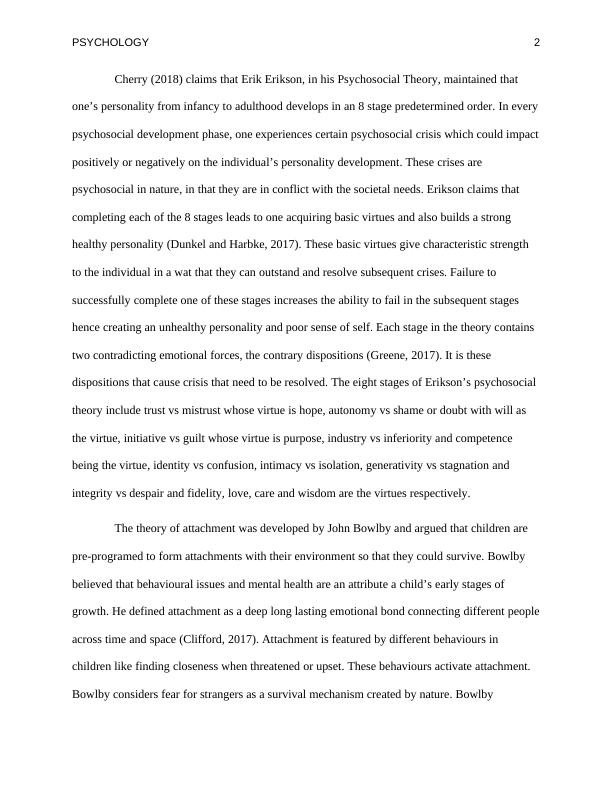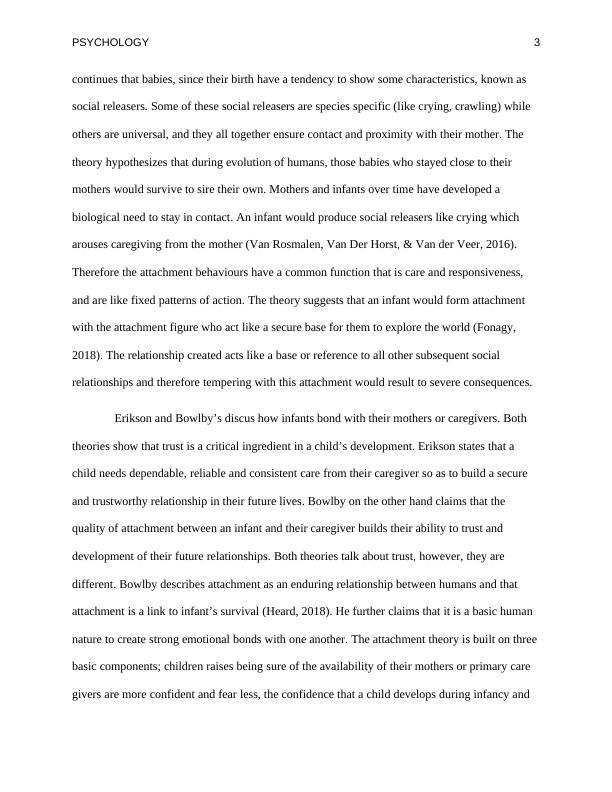Comparison Between Erikson’s Psychological theory and Bowlby’s Attachment Theory
Added on 2022-11-29
6 Pages1604 Words423 Views
Running head: PSYCHOLOGY 1
Student name
Student No
Unit
Title: Comparison Between Erikson’s Psychological theory and Bowlby’s Attachment
Theory
Student name
Student No
Unit
Title: Comparison Between Erikson’s Psychological theory and Bowlby’s Attachment
Theory

PSYCHOLOGY 2
Cherry (2018) claims that Erik Erikson, in his Psychosocial Theory, maintained that
one’s personality from infancy to adulthood develops in an 8 stage predetermined order. In every
psychosocial development phase, one experiences certain psychosocial crisis which could impact
positively or negatively on the individual’s personality development. These crises are
psychosocial in nature, in that they are in conflict with the societal needs. Erikson claims that
completing each of the 8 stages leads to one acquiring basic virtues and also builds a strong
healthy personality (Dunkel and Harbke, 2017). These basic virtues give characteristic strength
to the individual in a wat that they can outstand and resolve subsequent crises. Failure to
successfully complete one of these stages increases the ability to fail in the subsequent stages
hence creating an unhealthy personality and poor sense of self. Each stage in the theory contains
two contradicting emotional forces, the contrary dispositions (Greene, 2017). It is these
dispositions that cause crisis that need to be resolved. The eight stages of Erikson’s psychosocial
theory include trust vs mistrust whose virtue is hope, autonomy vs shame or doubt with will as
the virtue, initiative vs guilt whose virtue is purpose, industry vs inferiority and competence
being the virtue, identity vs confusion, intimacy vs isolation, generativity vs stagnation and
integrity vs despair and fidelity, love, care and wisdom are the virtues respectively.
The theory of attachment was developed by John Bowlby and argued that children are
pre-programed to form attachments with their environment so that they could survive. Bowlby
believed that behavioural issues and mental health are an attribute a child’s early stages of
growth. He defined attachment as a deep long lasting emotional bond connecting different people
across time and space (Clifford, 2017). Attachment is featured by different behaviours in
children like finding closeness when threatened or upset. These behaviours activate attachment.
Bowlby considers fear for strangers as a survival mechanism created by nature. Bowlby
Cherry (2018) claims that Erik Erikson, in his Psychosocial Theory, maintained that
one’s personality from infancy to adulthood develops in an 8 stage predetermined order. In every
psychosocial development phase, one experiences certain psychosocial crisis which could impact
positively or negatively on the individual’s personality development. These crises are
psychosocial in nature, in that they are in conflict with the societal needs. Erikson claims that
completing each of the 8 stages leads to one acquiring basic virtues and also builds a strong
healthy personality (Dunkel and Harbke, 2017). These basic virtues give characteristic strength
to the individual in a wat that they can outstand and resolve subsequent crises. Failure to
successfully complete one of these stages increases the ability to fail in the subsequent stages
hence creating an unhealthy personality and poor sense of self. Each stage in the theory contains
two contradicting emotional forces, the contrary dispositions (Greene, 2017). It is these
dispositions that cause crisis that need to be resolved. The eight stages of Erikson’s psychosocial
theory include trust vs mistrust whose virtue is hope, autonomy vs shame or doubt with will as
the virtue, initiative vs guilt whose virtue is purpose, industry vs inferiority and competence
being the virtue, identity vs confusion, intimacy vs isolation, generativity vs stagnation and
integrity vs despair and fidelity, love, care and wisdom are the virtues respectively.
The theory of attachment was developed by John Bowlby and argued that children are
pre-programed to form attachments with their environment so that they could survive. Bowlby
believed that behavioural issues and mental health are an attribute a child’s early stages of
growth. He defined attachment as a deep long lasting emotional bond connecting different people
across time and space (Clifford, 2017). Attachment is featured by different behaviours in
children like finding closeness when threatened or upset. These behaviours activate attachment.
Bowlby considers fear for strangers as a survival mechanism created by nature. Bowlby

PSYCHOLOGY 3
continues that babies, since their birth have a tendency to show some characteristics, known as
social releasers. Some of these social releasers are species specific (like crying, crawling) while
others are universal, and they all together ensure contact and proximity with their mother. The
theory hypothesizes that during evolution of humans, those babies who stayed close to their
mothers would survive to sire their own. Mothers and infants over time have developed a
biological need to stay in contact. An infant would produce social releasers like crying which
arouses caregiving from the mother (Van Rosmalen, Van Der Horst, & Van der Veer, 2016).
Therefore the attachment behaviours have a common function that is care and responsiveness,
and are like fixed patterns of action. The theory suggests that an infant would form attachment
with the attachment figure who act like a secure base for them to explore the world (Fonagy,
2018). The relationship created acts like a base or reference to all other subsequent social
relationships and therefore tempering with this attachment would result to severe consequences.
Erikson and Bowlby’s discus how infants bond with their mothers or caregivers. Both
theories show that trust is a critical ingredient in a child’s development. Erikson states that a
child needs dependable, reliable and consistent care from their caregiver so as to build a secure
and trustworthy relationship in their future lives. Bowlby on the other hand claims that the
quality of attachment between an infant and their caregiver builds their ability to trust and
development of their future relationships. Both theories talk about trust, however, they are
different. Bowlby describes attachment as an enduring relationship between humans and that
attachment is a link to infant’s survival (Heard, 2018). He further claims that it is a basic human
nature to create strong emotional bonds with one another. The attachment theory is built on three
basic components; children raises being sure of the availability of their mothers or primary care
givers are more confident and fear less, the confidence that a child develops during infancy and
continues that babies, since their birth have a tendency to show some characteristics, known as
social releasers. Some of these social releasers are species specific (like crying, crawling) while
others are universal, and they all together ensure contact and proximity with their mother. The
theory hypothesizes that during evolution of humans, those babies who stayed close to their
mothers would survive to sire their own. Mothers and infants over time have developed a
biological need to stay in contact. An infant would produce social releasers like crying which
arouses caregiving from the mother (Van Rosmalen, Van Der Horst, & Van der Veer, 2016).
Therefore the attachment behaviours have a common function that is care and responsiveness,
and are like fixed patterns of action. The theory suggests that an infant would form attachment
with the attachment figure who act like a secure base for them to explore the world (Fonagy,
2018). The relationship created acts like a base or reference to all other subsequent social
relationships and therefore tempering with this attachment would result to severe consequences.
Erikson and Bowlby’s discus how infants bond with their mothers or caregivers. Both
theories show that trust is a critical ingredient in a child’s development. Erikson states that a
child needs dependable, reliable and consistent care from their caregiver so as to build a secure
and trustworthy relationship in their future lives. Bowlby on the other hand claims that the
quality of attachment between an infant and their caregiver builds their ability to trust and
development of their future relationships. Both theories talk about trust, however, they are
different. Bowlby describes attachment as an enduring relationship between humans and that
attachment is a link to infant’s survival (Heard, 2018). He further claims that it is a basic human
nature to create strong emotional bonds with one another. The attachment theory is built on three
basic components; children raises being sure of the availability of their mothers or primary care
givers are more confident and fear less, the confidence that a child develops during infancy and

End of preview
Want to access all the pages? Upload your documents or become a member.
Related Documents
Report On Mother & Child Relationship - Bowlby's Theory Of Attachmentlg...
|12
|3099
|392
